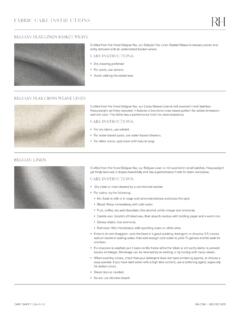Transcription of Software-Defined Access Medium and Large Site Fabric ...
1 2019 Cisco and/or its affiliates. All rights reserved. Page 1 of 84 Software-Defined Access Medium and Large Site Fabric Provisioning Solution Adoption Prescriptive Reference Deployment Guide October 2019 First Publish: August 23, 2019 Last Update: October 10, 2019 Prescriptive Deployment Guide Cisco Public 2019 Cisco and/or its affiliates. All rights reserved. Page 2 of 84 Contents Hardware and Software Version Summary .. 3 About this Guide .. 4 5 Design .. 6 Deploy .. 8 Process 1: Preparing for Network Management Automation .. 8 Process 2: Using Cisco DNA Center for Initial Network Design and Discovery .. 17 Process 3: Creating Segmentation and Policy for the SD- Access Network.
2 29 Process 4: Using Cisco DNA Center for Device Discovery .. 32 Process 4: Managing Device Software Images .. 36 Process 5: Creating a WLC HA SSO Pair .. 39 Process 6: Provisioning the Underlay Network for SD- Access .. 41 Operate .. 50 Process 1: Provisioning the SD- Access Overlay Network .. 50 Appendix A: Product List .. 69 Appendix B: Configuring TACACS .. 72 Appendix C: Initial IP Reachability and Route Redistribution .. 77 Feedback .. 84 2019 Cisco and/or its affiliates. All rights reserved. Page 3 of 84 Hardware and Software Version Summary Table 1. Hardware and software version summary Product Part number Software version Cisco DNA Center Appliance DN2-HW-APL-L (M5-based chassis) (System ) Cisco Identity Services Engine R-ISE-VMM-K9= Patch 6 Cisco Wireless LAN Controller Cisco 8540, 5520, and 3504 Series Wireless Controllers ( MR1) Cisco IOS XE Software See Appendix A for complete listing IOS XE 2019 Cisco and/or its affiliates.
3 All rights reserved. Page 4 of 84 About this Guide This guide contains four major sections: The DEFINE section defines Software-Defined Access , its relationship to Cisco DNA Center, and provides information on companion Solution Guides. The DESIGN section shows the deployment topology, described the routing protocols and redistribution modalities, and discussions the drivers behind these modalities. The DEPLOY section showcases the use of the DESIGN and POLICY applications in Cisco DNA Center along with the corresponding Discovery and Inventory Tools. LAN Automation and SWIM are used to onboard devices that will be used as the part of the SD- Access Fabric .
4 The OPERATE demonstrates the PROVISION application to deploy a Fabric site for both wired and wireless clients. Access to shared services and fusion routers are discussion and manually configured. 2019 Cisco and/or its affiliates. All rights reserved. Page 5 of 84 Define This section introduces the Software-Defined Access solution and how its relationship to Cisco DNA Center. It also provides links to additional resources, companion guides, and a link to ensure the current copy is the latest version of this guide. About SD- Access & Cisco DNA Center Cisco Software-Defined Access (SD- Access ) is the evolution from traditional campus LAN designs to networks that directly implement the intent of an organization.
5 SD- Access is enabled with an application package that runs as part of the Cisco DNA Center software for designing, provisioning, applying policy, and facilitating the creation of an intelligent campus wired and wireless network with assurance. This guide is used to deploy a Cisco Software-Defined Access Fabric . The deployment described in this guide is used after deploying the management infrastructure of Cisco DNA Center, Cisco Identity Services Engine (ISE), and Cisco Wireless LAN Controllers (WLC) described in the companion Software-Defined Access & Cisco DNA Center Management Infrastructure Prescriptive Deployment Guide. Companion Resources Find the companion Software-Defined Access Solution Design Guide, Software-Defined Access & Cisco DNA Center Management Infrastructure Prescriptive Deployment Guide, Software-Defined Access for Distributed Campus Prescriptive Deployment Guide, related deployment guides, design guides, and white papers, at the following pages: If you didn t download this guide from Cisco Community or Design Zone, you can check for the latest version of this guide.
6 Scale Metrics and Latency Information For scale metrics and latency information, please see the SD- Access Resources and Latency Design Guidance on Cisco Communities. 2019 Cisco and/or its affiliates. All rights reserved. Page 6 of 84 Design This section provides an overview of the topology used throughout this guide as well as the routing modalities used to provide IP reachability. Validation topology Tech tip For diagram simplicity and ease of reading, the intermediate nodes (distribution layer) is not show in the topology. For ease of initial understanding, Fabric border and control functionally will be collocated on the core switches.
7 The validation topology represents a Medium site as described in the companion Software-Defined Access Solution Design Guide. It shows a single building with multiple wiring closets that is part of a larger multiple-building network that aggregates each building s core switches to a pair of super core routers. The shared services block contains a virtual switching system (VSS) Catalyst 6800 switch providing Access to the Wireless LAN Controllers, Cisco DNA Center, the Identity Services Engine, Windows Active Directory, and DHCP/DNS servers. 2019 Cisco and/or its affiliates. All rights reserved. Page 7 of 84 Routing and Redistribution topology The existing enterprise network deployment runs the Enhanced Interior Gateway Routing Protocol (EIGRP) as a routing protocol.
8 This provides IP reachability between the super core routers, shared services, and the enterprise edge firewalls. The building core switches operate as the Fabric border and control plane nodes creating the northbound boundary of the Fabric site. Taking advantage of the LAN automation capabilities of Cisco DNA Center, the network infrastructure southbound of the core switches run the Intermediate System to Intermediate System (IS-IS) routing protocol. Between the Fabric border and the super core, BGP is used. Routes from the existing enterprise network are mutually redistributed between EIGRP and BGP. A route-map with is used to set an arbitrary tag value to prevent redistribution routing loops between EIRGP and BGP when using multiple redistribution points.
9 Routes from the SD- Access Fabric site are mutually redistributed between IS-IS and BGP which in turn are redistributed into EIGRP allowing end-to-end IP reachability. IP prefixes for shared services must be available to both the Fabric underlay and overlay networks while maintaining isolation among overlay networks. To maintain the isolation, VRF-lite extends from the Fabric border nodes to a set of fusion routers. The fusion routers implement VRF route leaking using a BGP route target import and export configuration. This is completed in later procedures after the Fabric roles are provisioned. For initial IP reachability between Cisco DNA Center and the Fabric site, BGP is manually configured.
10 Once a device is discovered and managed by Cisco DNA Center, it is recommended practice to not manually add configuration, particularly any configuration that might be overridden through the automated configuration placing the device in an unintended state. The exception is the manual IBGP configuration needed between redundant border nodes to help improve convergence times and provide alternative forwarding paths in certain upstream node or interface failure scenarios. 2019 Cisco and/or its affiliates. All rights reserved. Page 8 of 84 In deployments with multiple points of redistribution between several routing protocols, using BGP for initial IP reachability northbound of the border nodes helps ensure continued connectivity after the Fabric overlay is provisioned without the need for additional manual redistribution commands on the border nodes.

















